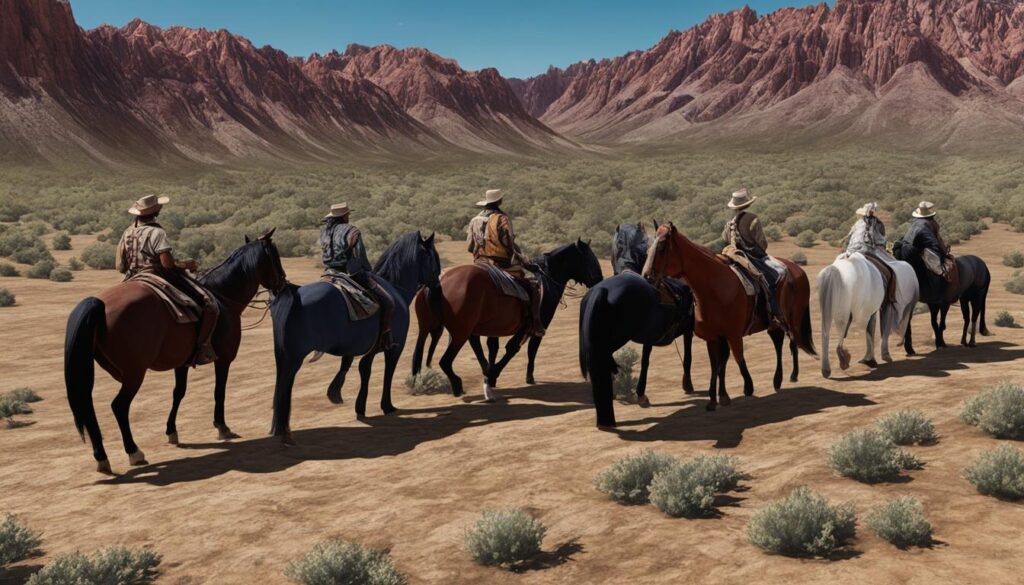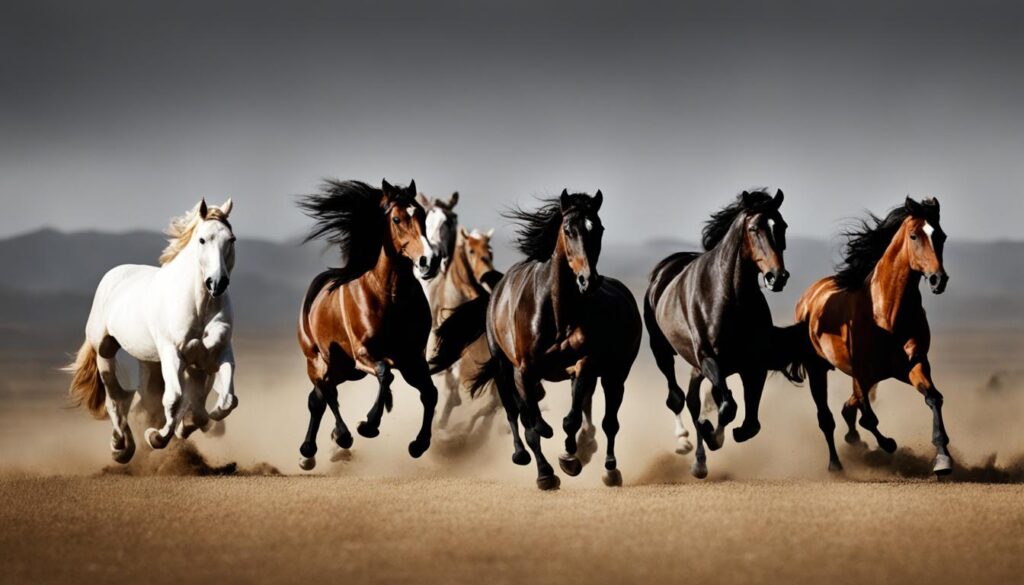Welcome to this literary journey as we delve deep into Cormac McCarthy’s “All the Pretty Horses” in this audiobook review. As one of McCarthy’s most iconic works, “All the Pretty Horses” has captured the hearts and imaginations of countless readers and listeners alike. In this review, we will provide an insightful analysis of the audiobook adaptation, exploring its strengths and weaknesses as well as its impact on the audiobook industry. Join us as we embark on a journey through the pages of this literary masterpiece.
Overview of “All the Pretty Horses”
If you are a fan of the American West and coming of age tales, “All the Pretty Horses” by Cormac McCarthy is an audiobook you won’t want to miss. Set in the late 1940s, the story centers around John Grady Cole, a 16-year-old cowboy who embarks on a journey from Texas to Mexico with his best friend Lacey Rawlins.
The plot takes a turn when the boys encounter a third traveler, Jimmy Blevins, and decide to continue their journey together. The trio faces various obstacles along the way, including run-ins with corrupt Mexican officials and a dangerous run-in with a gang of horse thieves. Through it all, John Grady’s journey becomes a profound exploration of identity, love, and the hardships of life in the American West.
The novel’s main characters are John Grady Cole, a young and determined cowboy; Lacey Rawlins, John Grady’s best friend; and Jimmy Blevins, a mysterious and flawed third traveler who joins the journey.
Writing Style and Language
Cormac McCarthy is widely celebrated for his unique writing style that combines raw and gritty realism with poetic lyricism, all while experimenting with unconventional phrasing and punctuation that often defies grammatical convention. In “All the Pretty Horses,” McCarthy’s prose is strikingly sparse, devoid of unnecessary adjectives or adverbs, and characterized by short, declarative sentences that are deceptively simple but convey a great depth of meaning. His use of language is as much about what he leaves out as what he includes, relying on the reader’s imagination to fill in the gaps and construct vivid mental images of the story’s landscapes and characters.
McCarthy also employs a distinctively Western dialect in his dialogue, conveying the nuances and rhythms of the cowboy culture he writes about. He captures the essence of the language in use during the period, and the vocabulary and expressions he employs perfectly capture the unique contrast between the harsh life on the trails and the dream of a better life at the end.
Imagery and Symbolism
“The sky was pewter, the color of lead, and the light was gray and fading. They rode out on the high prairie where they slowed the horses to a walk and the stars swarmed around them out of the blackness. He could hear the horses’ breathing and he could see the shapes of the other two riders black against the blue and dying light. They rode like men invested with a purpose whose origins were antecedent to them, like blood legatees of an order both imperative and remote.”
McCarthy’s use of imagery and symbolism in “All the Pretty Horses” is equally masterful. The bleak beauty of the Texan landscape serves as a powerful metaphor for the harsh realities of the cowboy life, and the relationship between John Grady Cole and his horse reflects the deep connection between humans and the natural world. The use of wolves as symbols of death, danger, and the primal forces of nature adds another layer of meaning to the narrative that rewards careful examination.
McCarthy’s writing style and use of language are essential components of the novel’s success, helping to create a vivid and fully realized world that draws readers in and immerses them in an unforgettable story.
Themes Explored in “All the Pretty Horses”
Cormac McCarthy’s “All the Pretty Horses” is a literary masterpiece that explores a variety of themes throughout the course of the narrative. One of the central themes present in the story is the struggle between tradition and modernity. The main character, John Grady Cole, finds himself caught between the old ways of the vaquero and the new reality of the modern world.
Another theme McCarthy delves into is the concept of masculinity and what it means to be a man. John Grady Cole and his partner, Lacey Rawlins, are both searching for a sense of purpose and identity in a world that seems to have lost its way. Through their experiences, the novel explores what it means to be a man in this rapidly changing world.
The theme of love is another important element in “All the Pretty Horses.” The love story between John Grady Cole and Alejandra highlights the idea of love as a dangerous passion that can lead to both joy and heartbreak. McCarthy’s portrayal of love is both romantic and realistic, capturing the complexities of this powerful emotion.
Finally, “All the Pretty Horses” grapples with the theme of mortality and the passage of time. Through the characters’ journeys and experiences, the novel suggests that life is fleeting, and that one must make the most of their time on this earth before it’s too late.
“I don’t know how to tell you,” he said. “I guess the truth is I don’t but half know anything else except I love you more than anything in this world and I’m at your mercy.”
The Deeper Meaning in “All the Pretty Horses”
At its core, “All the Pretty Horses” is a meditation on the human experience. Through its exploration of tradition, identity, love, and mortality, the novel presents a deeply moving and thought-provoking story that resonates with readers long after they have finished reading it.
One of the key takeaways from “All the Pretty Horses” is that life is about more than just material success. The characters in the novel are searching for something deeper and more meaningful than mere possessions; they are searching for a sense of purpose and a connection to their past.
Another lesson to be gleaned from “All the Pretty Horses” is the importance of living in the moment. John Grady Cole and his companions are acutely aware of the fleeting nature of life, and they make the most of each day they have together. This is a valuable reminder to readers to savor each moment and appreciate the people in their lives.
Overall, “All the Pretty Horses” is a powerful and moving novel that offers a profound exploration of the human experience. Its themes of tradition and modernity, masculinity, love, and mortality, combined with McCarthy’s unique and evocative prose, make for a reading experience that is both unforgettable and deeply impactful.
Setting and Atmosphere
Cormac McCarthy’s “All the Pretty Horses” mesmerizes readers with its vivid descriptions of the setting and atmospheric details that immerse them in the story. The novel is set in the rugged landscapes of the American Southwest and Mexico, and McCarthy’s beautiful prose brings the natural world to life.
The sense of place is a crucial element of the story, and the reader is transported to a world where horses roam wild and free, and the vast expanse of the prairies seems to stretch out forever. McCarthy’s precise attention to detail evokes a strong connection to the setting, making the reader feel like they are standing in the middle of the story.
The atmospheric descriptions in “All the Pretty Horses” are truly breathtaking. From the vibrant hues of the sunset to the fragrant smell of sagebrush, McCarthy paints a vivid picture that elicits all the senses. The author’s poetic descriptions create a deeper emotional connection to the story, and the reader can almost feel the wind in their hair or smell the dust on the trails.
McCarthy’s gift for painting the setting and atmosphere of the story adds a layer of authenticity to the novel and allows readers to fully immerse themselves in the story. Through his masterful use of language, he creates a world that is so vivid, it becomes real.
Character Development in “All the Pretty Horses”
The characters in “All the Pretty Horses” undergo significant growth and development throughout the novel, exploring complex ideas of identity, morality, and culture. John Grady Cole, the protagonist, transforms from a naive and romantic teenager into a hardened, experienced cowboy. His journey is mirrored by that of his close companion, Lacey Rawlins, who similarly toughens up and becomes more pragmatic.
Their experiences on the open range and during their encounters with various people force them to confront difficult moral questions and make difficult decisions. These experiences shape who they become and are reflected in the novel’s exploration of identity. Over the course of the novel, John Grady and Lacey both begin to understand their place in the world, and how they fit within certain cultural and societal structures.
“He was destined for violent, solitary, and unimaginable death and the girl who rode with him would share it, whether she would or not”
The character development in “All the Pretty Horses” is expertly crafted, with each character’s journey interweaving together to create a powerful and cohesive narrative. McCarthy’s attention to detail and ability to evoke a sense of place and atmosphere enhances the characters’ growth and development, making their transformation all the more impactful. Through his storytelling, he explores deep and complex themes, creating a thought-provoking novel that leaves a lasting impression on readers.

Character Development Chart
| Character | Beginning of Novel | End of Novel |
|---|---|---|
| John Grady Cole | Naive, romantic, idealistic | Toughened, experienced |
| Lacey Rawlins | Artless, inexperienced | Pragmatic, experienced |
| Alejandra | Sheltered, innocent | Exposed to harsh realities, conflicted |
Narration and Audio Performance
The “All the Pretty Horses” audiobook brings McCarthy’s work to life with its immersive narration and standout audio performance.
The audiobook is narrated by Frank Muller, who expertly captures the essence of McCarthy’s writing style and the nuances of the characters. Muller’s voice adds to the atmospheric descriptions present in the novel, taking listeners on a journey through the American Southwest in the 1940s.
In addition to Muller’s narration, the audiobook features a talented cast of voice actors who bring the supporting characters to life. Their performances enhance the overall listening experience, creating a fully-realized, immersive world.
The narration and audio performance in the “All the Pretty Horses” audiobook make for a truly memorable and enjoyable listening experience, a must-have for both fans of McCarthy’s work and those new to his literary world.
Pacing and Structure
The pacing and narrative structure of “All the Pretty Horses” are masterfully crafted to enhance the overall reading experience. McCarthy’s use of descriptive language and imagery creates a vivid and immersive world that draws readers in, while the slow and deliberate pacing allows for a deeper exploration of the characters and themes.
The plot progression in “All the Pretty Horses” is natural and organic, with each event and decision leading seamlessly into the next. The narrative structure, while seemingly simple on the surface, is complex in its exploration of the characters’ motivations and emotions. The story builds gradually towards its climax, with each chapter building upon the last, culminating in a satisfying and emotional conclusion.
“The pacing of the novel is deliberately slow, allowing McCarthy to fully explore the characters’ internal struggles and the beauty of the Texas landscape. This, combined with the skillfully crafted narrative structure and plot progression, makes for a truly unforgettable reading experience.”
Critique of the Audiobook Adaptation
After delving into McCarthy’s literary masterpiece, it is time to put a critical eye on the audiobook adaptation of “All the Pretty Horses”. The overall performance is satisfactory and engaging, making it a pleasant experience for the listener. The narrative pacing is well-timed, and the voice actors’ renditions of characters enhance the listener’s experience.
However, some weaknesses are worth noting. One disappointment was the lack of a consistent accent in the dialogue portions. The story’s setting is in border areas shared by Mexico and Texas, demanding a bilingual approach. Instead, the voice actors used American accents in the language’s Spanish portions, which may offend people familiar with the area’s particularities.
Another factor to consider in this audiobook adaptation is the absence of the book’s Spanish phrases’ translations. This exclusion can confuse anyone unfamiliar with the language and may detract from their literary appreciation.
In conclusion, while the audiobook adaptation for “All the Pretty Horses” holds its ground in the storytelling and voice actors’ performances, it must improve its consistency regarding accents and translations to better align with the literary experience.
Comparable Works by Cormac McCarthy
In addition to “All the Pretty Horses,” Cormac McCarthy has written several other notable works that are comparable in terms of style, themes, and character development. The following list provides a brief overview of some of his most celebrated works:
| Work | Year Published | Summary |
|---|---|---|
| The Road | 2006 | A post-apocalyptic tale of a father and son’s journey through a barren America in search of safety and survival. The novel explores themes of love, hope, and humanity in the face of disaster. |
| No Country for Old Men | 2005 | A crime thriller set in the west Texas borderlands, following the cat-and-mouse chase between a gritty Vietnam veteran and a ruthless killer on the run. The novel explores the consequences of violence and the moral decay of society. |
| Blood Meridian | 1985 | An epic western novel set in the mid-19th century, following the violent exploits of a teenage runaway called “the Kid” and a gang of Indian hunters led by the enigmatic and brutal Judge Holden. The novel explores themes of masculinity, violence, and the human condition. |
Each of these works shares elements that make McCarthy’s writing distinctive, from his sparse, poetic language to his exploration of complex themes and characters. A comparative analysis of these works can shed further light on McCarthy’s unique literary style and the depths of his storytelling.
Reception and Awards
Upon its release in 1992, “All the Pretty Horses” received universal critical acclaim. With its profound exploration of the American identity, this Cormac McCarthy novel cemented its place as an American classic. The New York Times called it “a darkly shining work…utterly unsparing.”
Winner of the National Book Award and the National Book Critics Circle Award, “All the Pretty Horses” is a literary triumph. McCarthy’s choice to write about the American West—an often romanticized landscape—with brutal honesty and insight has garnered him countless accolades.
| Awards | Year |
|---|---|
| National Book Award | 1992 |
| National Book Critics Circle Award | 1992 |
| Literature Award from the American Academy of Arts and Letters | 1993 |
| Prix Femina Étranger (France) | 1993 |
Reviews
“All the Pretty Horses” is perhaps the finest novel in McCarthy’s celebrated career, as it exemplifies many of the qualities for which he has become admired throughout the world: a sense of purpose, a created world that is both concrete and ephemeral, a gift for metaphor that approaches the surreal, and an essentially tragic vision that nevertheless finds affirmation in the rituals of daily life.”
-David L. Ulin, Newsday
“The beauty of the novel, as well as its glory, lies in the laconic voice of its twenty-two-year-old Texan protagonist, John Grady Cole, and in Mr. McCarthy’s masterly orchestration of its narrative and themes…Mr. McCarthy has created an imaginative oeuvre greater than, say, the individual and self-contained creations of William Faulkner.”

Cultural Influence and Impact
The impact of All the Pretty Horses in the literary world is undeniable. The novel won the National Book Award in 1992, solidifying Cormac McCarthy’s reputation as one of the most influential American writers of the 20th century. The book has been translated into several languages and has become a staple in many high school and college literature curriculums.
The legacy of the book has also been felt in popular culture. The 2000 film adaptation, directed by Billy Bob Thornton and starring Matt Damon, helped introduce the story to a wider audience. The book’s themes of honor, love, and loss continue to resonate with readers of all ages and backgrounds.
The influence of All the Pretty Horses can also be seen in the western genre as a whole. Some critics argue that the book helped usher in a new era of western literature, one that does not shy away from the darker, more complex aspects of the genre. The book’s impact on the audiobook industry is also worth noting, as it helped popularize the format for a new generation of readers.
“All the Pretty Horses is a novel that speaks profoundly to the soul of its readers. It’s a book that explores the complexity of human emotions, the grandeur of the American West, and the power of storytelling. It’s a novel that will stay with you long after you finish reading it.”
Reader Recommendations
Looking for more audiobooks like “All the Pretty Horses”? Check out the following recommendations from fans and critics:
- The Road by Cormac McCarthy – If you enjoyed McCarthy’s writing style and philosophical themes in “All the Pretty Horses,” you’ll likely love this Pulitzer Prize-winning novel. Follow a father and son as they journey through an apocalyptic world filled with danger and despair.
- True Grit by Charles Portis – For fans of Westerns like “All the Pretty Horses,” this classic novel follows the story of a young girl seeking to avenge her father’s death in the Wild West. The audiobook is expertly narrated by Donna Tartt.
- The Crossing by Cormac McCarthy – Another novel by the same author, “The Crossing” is the second in McCarthy’s Border Trilogy and explores similar themes of coming-of-age and self-discovery in the American West.
- East of Eden by John Steinbeck – Readers who enjoyed the epic scope and character development of “All the Pretty Horses” will appreciate this classic novel, which spans three generations and explores themes of good and evil.
Personal Reflections
Reading “All the Pretty Horses” through the audiobook format was a uniquely personal experience that left an indelible impression on me. The rich language and vivid imagery of Cormac McCarthy’s prose combined with the expert narration brought the story to life, immersing me in a world both foreign and familiar.
As I listened, I found myself connecting with the characters on a deep level, experiencing their triumphs and tragedies as if they were my own. The audiobook format added an emotional layer to the story, allowing me to feel every moment with clarity and depth.
Through the journey of John Grady Cole and his fellow adventurers, I found myself reflecting on the concept of freedom and what it truly means to be alive. McCarthy’s exploration of these themes resonated with me on a personal level, causing me to contemplate my own life and the choices I’ve made.
Overall, “All the Pretty Horses” is a remarkable work of literature that transcends time and place, connecting deeply with readers and listeners alike. The audiobook adaptation only amplifies the impact of this powerful story, and I highly recommend it to anyone looking for a truly unforgettable literary experience.
Impact on the Audiobook Industry
Since its original publication in 1992, “All the Pretty Horses” has become a literary classic, inspiring countless readers and listeners alike with its captivating storytelling and profound themes. However, the impact of Cormac McCarthy’s masterpiece extends beyond the world of literature, influencing the audiobook industry to this day.
One of the most significant trends to emerge from “All the Pretty Horses” is the focus on high-quality audio performances, featuring talented voice actors who bring the characters and story to life in new ways. The audiobook adaptation of this novel has set a high standard for immersive and engaging storytelling, inspiring other audiobooks to follow suit.
Furthermore, “All the Pretty Horses” has also influenced the way audiobooks are marketed and promoted, with publishers and retailers capitalizing on the popularity of this novel to highlight other literary works in a similar genre or style. The success of the audiobook adaptation has proven the viability of audiobooks as a format for enjoying literary works, leading to increased demand and a growing market for these productions.
Overall, the influence of “All the Pretty Horses” on the audiobook industry cannot be overstated. This novel has inspired new trends and developments in audio performance, marketing, and production, leaving a lasting legacy that continues to shape the industry today.
Conclusion
In conclusion, Cormac McCarthy’s “All the Pretty Horses” is a literary masterpiece that takes readers on a profound journey through themes of love, loss, and self-discovery. The audiobook adaptation offers a compelling and immersive experience, with skilled voice actors bringing the characters to life.
McCarthy’s unique writing style, use of language, and atmospheric descriptions create a vivid sense of place that transports readers to the rugged landscapes of Texas and Mexico. The novel’s pacing and narrative structure enhance the reading experience, while the character development provides a complex and layered exploration of the main characters.
The audiobook adaptation of “All the Pretty Horses” has had a significant impact on the audiobook industry, inspiring trends and developments. Its cultural influence is undeniable, with critical acclaim and numerous awards and recognition. Highly recommended for readers and listeners seeking an emotionally impactful and thought-provoking literary journey.



